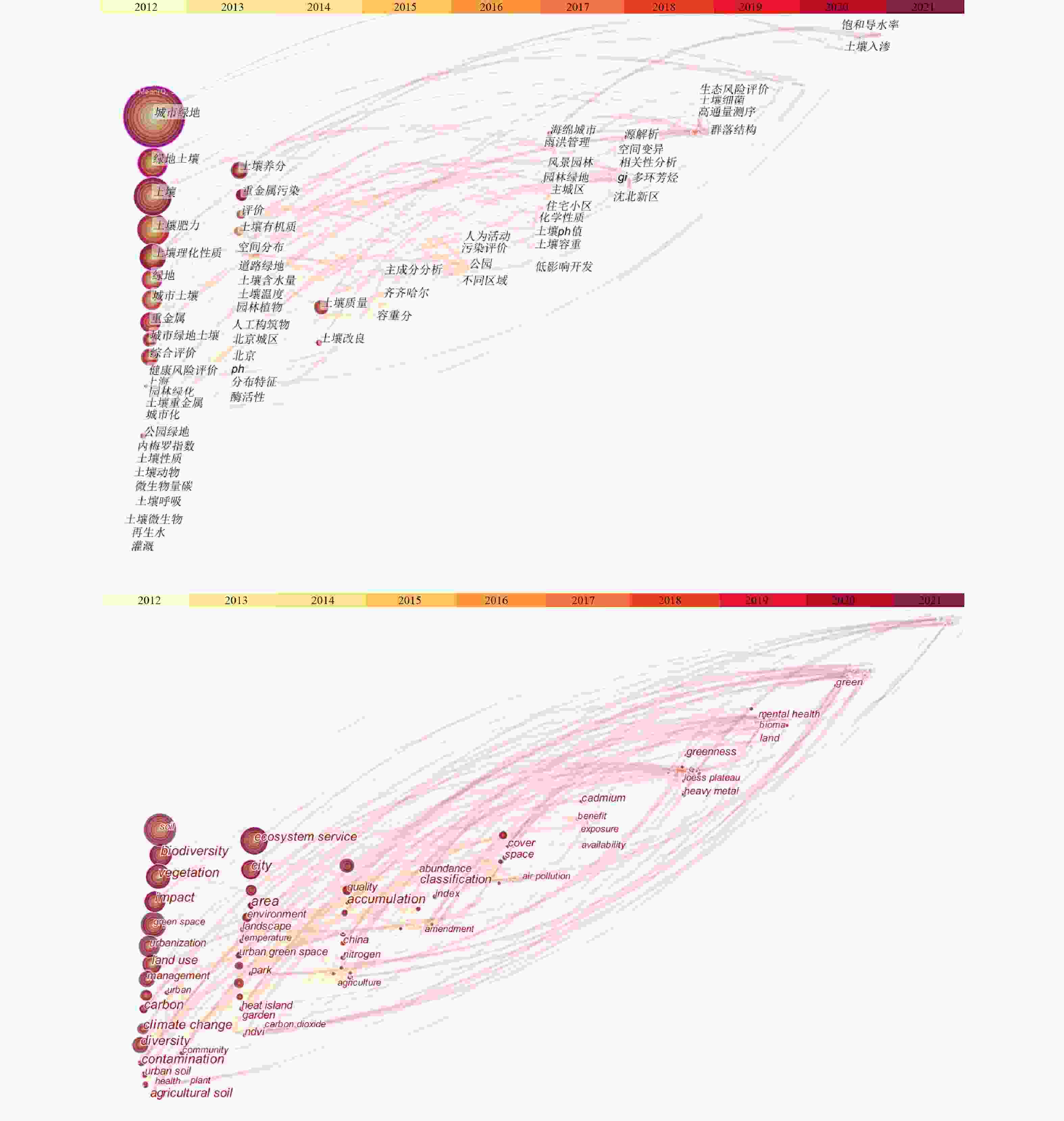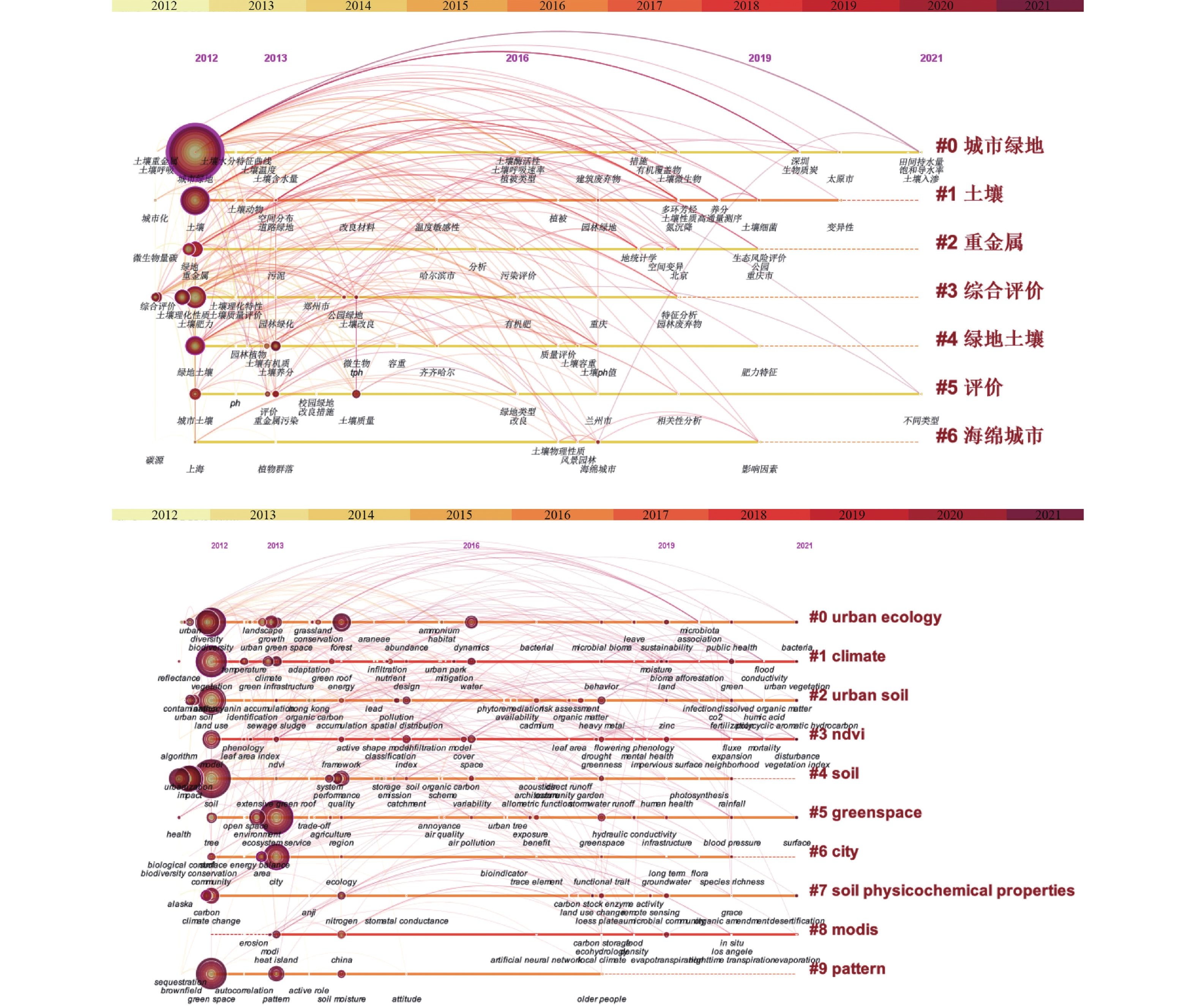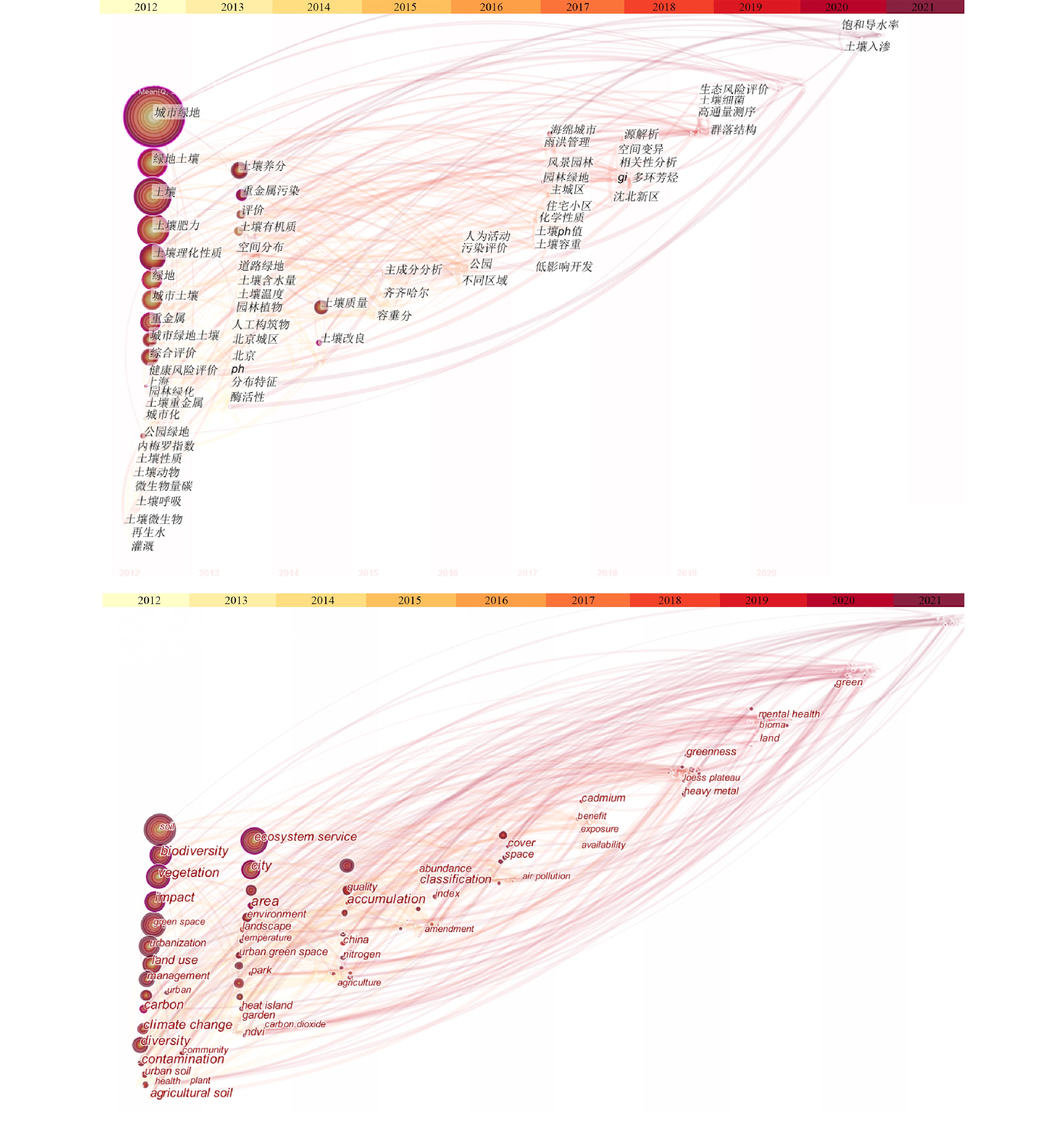| [1] |
秦娟, 许克福. 我国城市绿地土壤质量研究综述与展望[J]. 生态科学, 2018, 37(1): 200 − 210. |
QIN Juan, XU Kefu. Research summary and prospect of urban green space soil quality in China [J]. Ecological Science, 2018, 37(1): 200 − 210. |
| [2] |
苏泳娴, 黄光庆, 陈修治, 等. 城市绿地的生态环境效应研究进展[J]. 生态学报, 2011, 31(23): 7287 − 7300. |
SU Yongxian, HUANG Guangqing, CHEN Xiuzhi, et al. Research progress in the eco-environmental effects of urban green spaces [J]. Acta Ecologica Sinica, 2011, 31(23): 7287 − 7300. |
| [3] |
AJMONE-MARSAN F, BIASIOLI M. Trace elements in soils of urban areas [J]. Water,Air,&Soil Pollution, 2010, 213: 121 − 143. |
| [4] |
ELLIS E C. Anthropogenic transformation of the terrestrial biosphere [J]. Philosophical Transactions of the Royal Society A, 2011, 369(1938): 1010 − 1035. |
| [5] |
VRŠČAJ B, POGGIO L, MARSAN F A. A method for soil environmental quality evaluation for management and planning in urban areas [J]. Landscape and Urban Planning, 2008, 88(2/4): 81 − 94. |
| [6] |
de KIMPE C R, MOREL J L. Urban soil management: a growing concern [J]. Soil Science, 2000, 165(1): 31 − 40. |
| [7] |
邹明珠, 王艳春, 刘燕. 北京城市绿地土壤研究现状及问题[J]. 中国土壤与肥料, 2012(3): 1 − 6. |
ZOU Mingzhu, WANG Yanchun, LIU Yan. The present status and problems of the research on Beijing urban green space soil [J]. Soil and Fertilizer Sciences in China, 2012(3): 1 − 6. |
| [8] |
方海兰, 陈玲, 黄懿珍, 等. 上海新建绿地的土壤质量现状和对策[J]. 林业科学, 2007, 43(增刊 1): 89 − 94. |
FANG Hailan, CHEN Ling, HUANG Yizhen, et al. Current situation and strategy for the soil quality of newly-established green belts in Shanghai [J]. Scientia Silvae Sinicae, 2007, 43(suppl 1): 89 − 94. |
| [9] |
吕子文, 方海兰, 黄彩娣. 美国园林废弃物的处置及对我国的启示[J]. 中国园林, 2007, 24(8): 90 − 94. |
LÜ Ziwen, FANG Hailan, HUANG Caidi. The disposing of green waste in USA and the inspiration for its utilization in China [J]. Chinese Landscape Architecture, 2007, 24(8): 90 − 94. |
| [10] |
梁晶, 吕子文, 方海兰. 园林绿色废弃物堆肥处理的国外现状与我国的出路[J]. 中国园林, 2009, 26(4): 1 − 6. |
LIANG Jing, LÜ Ziwen, FANG Hailan. Status of composting treatment of garden waste abroad and application in China [J]. Chinese Landscape Architecture, 2009, 26(4): 1 − 6. |
| [11] |
梁晶, 方海兰, 张浪, 等. 基于城市绿地土壤安全的主要生态技术研究及应用[J]. 中国园林, 2016, 32(8): 14 − 17. |
LIANG Jing, FANG Hailan, ZHANG Lang, et al. Study and application of main ecology technology based on soil security for urban landscape [J]. Chinese Landscape Architecture, 2016, 32(8): 14 − 17. |
| [12] |
伍海兵, 方海兰, 彭红玲, 等. 典型新建绿地上海辰山植物园的土壤物理性质分析[J]. 水土保持学报, 2012, 26(6): 85 − 90. |
WU Haibing, FANG Hailan, PENG Hongling, et al. Soil physical properties analysis of the typical newly-established green belt of Shanghai Chenshan Botanical Garden [J]. Journal of Soil and Water Conservation, 2012, 26(6): 85 − 90. |
| [13] |
伍海兵, 李爱平, 方海兰, 等. 绿地土壤孔隙度检测方法及其对土壤肥力评价的重要性[J]. 浙江农林大学学报, 2015, 32(1): 98 − 103. |
WU Haibing, LI Aiping, FANG Hailan, et al. Green-belt soil testing methods for porosity and the importance of porosity on soil fertility evaluation [J]. Journal of Zhejiang A&F University, 2015, 32(1): 98 − 103. |
| [14] |
伍海兵, 张青青, 梁晶. 城市绿地土壤肥力质量综合评价方法初探[J]. 土壤通报, 2020, 51(4): 795 − 800. |
WU Haibing, ZHANG Qingqing, LIANG Jing. A comprehensive evaluation method of soil fertility quality in urban green space [J]. Chinese Journal of Soil Science, 2020, 51(4): 795 − 800. |
| [15] |
伍海兵. 城市绿地土壤物理性质特征及其改良研究[D]. 南京: 南京农业大学, 2013. |
WU Haibing. Research on Character of Soil Physical Properties and its Improvement of Urban Green Space[D]. Nanjing: Nanjing Agricultural University, 2013. |
| [16] |
伍海兵. 上海中心城区典型绿地土壤物理性质特征研究[J]. 土壤, 2018, 50(1): 155 − 161. |
WU Haibing. Study on soil physical properties of green belts in central urban area of Shanghai [J]. Soils, 2018, 50(1): 155 − 161. |
| [17] |
朱本国, 王丽娟, 陈祥, 等. 城市居住区园林景观绿地土壤质量分析和改良建议[J]. 现代园艺, 2019, 42(23): 29 − 30, 41. |
ZHU Benguo, WANG Lijuan, CHEN Xiang, et al. Soil quality analysis and improvement suggestions for garden landscape green land in urban residential areas [J]. Xiandai Horticulture, 2019, 42(23): 29 − 30, 41. |
| [18] |
朱本国, 胡艳燕, 包兵, 等. 城市新老城区绿地土壤铅积累情况浅析——以重庆市沙坪坝区大学城为例[J]. 中国园艺文摘, 2016, 32(2): 110 − 112, 183. |
ZHU Benguo, HU Yanyan, BAO Bing, et al. Analysis on lead accumulation in new and old urban areas [J]. Chinese Horticulture Abstracts, 2016, 32(2): 110 − 112, 183. |
| [19] |
徐福银, 胡艳燕. 重庆市不同功能区城市绿地土壤重金属分布特征与评价[J]. 土壤通报, 2014, 45(1): 227 − 231. |
XU Fuyin, HU Yanyan. Distribution and pollution assessment on heavy metals in urban soils of different functional areas in Chongqing [J]. Chinese Journal of Soil Science, 2014, 45(1): 227 − 231. |
| [20] |
卢瑛, 龚子同, 张甘霖, 等. 南京城市土壤重金属含量及其影响因素[J]. 应用生态学报, 2004, 15(1): 123 − 126. |
LU Ying, GONG Zitong, ZHANG Ganlin, et al. Heavy metal concentration in Nanjing urban soils and their affecting factors [J]. Chinese Journal of Applied Ecology, 2004, 15(1): 123 − 126. |
| [21] |
卢瑛, 甘海华, 史正军, 等. 深圳城市绿地土壤肥力质量评价及管理对策[J]. 水土保持学报, 2005, 19(1): 153 − 156. |
LU Ying, GAN Haihua, SHI Zhengjun, et al. Soil fertility quality assessment and managing measures for urban green space in Shenzhen City [J]. Journal of Soil and Water Conservation, 2005, 19(1): 153 − 156. |
| [22] |
边振兴, 王秋兵. 沈阳市公园绿地土壤养分特征的研究[J]. 土壤通报, 2003, 34(4): 284 − 290. |
BIAN Zhenxing, WANG Qiubing. Study on urban park soil nutrients in Shenyang City’s green areas [J]. Chinese Journal of Soil Science, 2003, 34(4): 284 − 290. |
| [23] |
张琪, 方海兰, 黄懿珍, 等. 土壤阳离子交换量在上海城市土壤质量评价中的应用[J]. 土壤, 2005, 37(6): 679 − 682. |
ZHANG Qi, FANG Hailan, HUANG Yizhen, et al. Application of soil CEC to evaluation of soil quality in Shanghai [J]. Soils, 2005, 37(6): 679 − 682. |
| [24] |
PENG Chi, OUYANG Zhiyun, WANG Mei’e, et al. Vegetative cover and PAHs accumulation in soils of urban green space [J]. Environment Pollution, 2012, 161: 36 − 42. |
| [25] |
LIN Mao, LI Suyan, SUN Xiangyang, et al. Heavy metal contamination in green space soils of Beijing, China [J]. Acta Agriculturae Scandinavica,Section B-Soil &Plant Science, 2018, 68(4): 291 − 300. |
| [26] |
SELWAY C A, MILLS J G, WEINSTEIN P, et al. Transfer of environmental microbes to the skin and respiratory tract of humans after urban green space exposure [J/OL]. Environment International, 2020, 145: 106084[2022-10-15]. doi: 10.1016/j.envint.2020.106084. |
| [27] |
GUO Peipei, YU Fang, REN Yuan, et al. Response of ruderal species diversity to an urban environment: implications for conservation and management [J/OL]. International Journal of Environmental Research and Public Health, 2018, 15(12): 2832[2022-10-15]. doi: 10.3390/ijerph15122832. |
| [28] |
MILLS J G, WEINSTEIN P, GELLIE N J C, et al. Urban habitat restoration provides a human health benefit through microbiome rewilding: the microbiome rewilding hypothesis [J]. Restoration Ecology, 2017, 25(6): 866 − 872. |
| [29] |
CAMERON R W F, BLANUŠA T, TAYLOR J E, et al. The domestic garden - its contribution to urban green infrastructure [J]. Urban Forestry &Urban Greening, 2012, 11(2): 129 − 137. |
| [30] |
LIVESLEY S J, MCPHERSON E G, CALFAPIETRA C. The urban forest and ecosystem services: impacts on urban water, heat, and pollution cycles at the tree, street, and city scale [J]. Journal of Environment Quality, 2016, 45: 119 − 124. |
| [31] |
COUTTS A M, TAPPER N J, BERINGER J, et al. Watering our cities: the capacity for Water Sensitive Urban Design to support urban cooling and improve human thermal comfort in the Australian context [J]. Progress in Physical Geography-Earth and Environment, 2013, 37(1): 2 − 28. |
| [32] |
KABISCH N, HAASE D. Green spaces of European cities revisited for 1990−2006 [J]. Landscape and Urban Planning, 2013, 110: 113 − 122. |
| [33] |
BRAAKER S, GHAZOUL J, OBRIST M K, et al. Habitat connectivity shapes urban arthropod communities: the key role of green roofs [J]. Ecology, 2014, 95(4): 1010 − 1020. |
| [34] |
张明, 潘国林, 张宗应, 等. 我国部分城市绿地土壤肥力质量分析与评价[J]. 内蒙古农业大学学报(自然科学版), 2019, 40(3): 46 − 51. |
ZHANG Ming, PAN Guolin, ZHANG Zongying, et al. Soil fertility quality analysis and evaluation in some urban green space of China [J]. Journal of Inner Mongolia Agricultural University (Natural Science Edition), 2019, 40(3): 46 − 51. |
| [35] |
赵靓, 梁云平, 陈倩, 等. 中国北方某市城市绿地土壤重金属空间分布特征、污染评价及来源解析[J]. 环境科学, 2020, 41(12): 5552 − 5561. |
ZHAO Liang, LIANG Yunping, CHEN Qian, et al. Spatial distribution contamination assessment and sources of heavy metals in the urban green space soils of a city in North China [J]. Environmental Science, 2020, 41(12): 5552 − 5561. |
| [36] |
赵卓亚, 王志刚, 毕拥国, 等. 保定市城市绿地土壤重金属分布及其风险评价[J]. 河北农业大学学报, 2009, 32(2): 16 − 20. |
ZHAO Zhuoya, WANG Zhigang, BI Yongguo, et al. The distributions and risk assessment of heavy metals in the soils from different urban greenland region of Baoding city [J]. Journal of Agricultural University of Hebei, 2009, 32(2): 16 − 20. |
| [37] |
杨建宇, 欧聪, 李琪, 等. 基于云模型的吉林大安耕地土壤养分模糊综合评价[J]. 农业机械学报, 2018, 49(1): 251 − 257. |
YANG Jianyu, OU Cong, LI QI, et al. Fuzzy synthetic evaluation of soil nutrients in cultivated land based on cloud model in Da’an City, Jilin Province [J]. Transactions of the Chinese Society of Agricultural Machinery, 2018, 49(1): 251 − 257. |
| [38] |
周长松, 邹胜章, 李录娟, 等. 几种土壤重金属污染评价方法的对比[J]. 地球与环境, 2015, 43(6): 709 − 713. |
ZHOU Changsong, ZOU Shengzhang, LI Lujuan, et al. Comparison of evaluation methods for soil heavy metals contamination [J]. Earth and Environment, 2015, 43(6): 709 − 713. |
| [39] |
鲍思屹, 徐梦洁, 解菁菁, 等. 红壤耕地重金属含量空间变异与潜在生态风险的不确定性——以鹰潭市余江区为例[J]. 天津农业科学, 2020, 26(7): 55 − 61. |
BAO Siyi, XU Mengjie, XIE Jingjing, et al. Spatial variability of heavy metal content in cultivated land of red soil and uncertainty of potential ecological risks: a case of Yujiang District, Yingtan City [J]. Tianjin Agricultural Science, 2020, 26(7): 55 − 61. |
| [40] |
易文利, 董奇, 杨飞, 等. 宝鸡市不同功能区土壤重金属污染特征、来源及风险评价[J]. 生态环境学报, 2018, 27(11): 2142 − 2149. |
YI Wenli, DONG Qi, YANG Fei, et al. Pollution characteristics, sources analysis and potential ecological risk assessment of heavy metals in different functional zones of Baoji City [J]. Ecology and Environment Science, 2018, 27(11): 2142 − 2149. |
| [41] |
康彩霞. GIS与地统计学支持下的哈尔滨市土壤重金属污染评价与空间分布特征研究[D]. 长春: 吉林大学, 2009. |
KANG Caixia. Study on Evaluation and Spatial Distribution Characteristics of Heavy Metal Pollution in Soil of Harbin Base on GIS and Geo-statistics [D]. Changchun: Jilin University, 2009. |
| [42] |
谢贤健, 韩光中. 基于普通克里格和投影寻踪模型的城市土壤重金属污染评价[J]. 生态环境学报, 2017, 26(9): 1584 − 1590. |
XIE Xianjian, HAN Guangzhong. Evaluation of soil heavy metal pollution in Neijiang City based on ordinary Kriging and Projection Pursuit Model [J]. Ecology and Environment Science, 2017, 26(9): 1584 − 1590. |
| [43] |
张俊叶, 刘晓东, 庞少东, 等. 物元可拓法用于南京城市绿地土壤重金属污染评价[J]. 环境科学研究, 2018, 31(9): 1572 − 1579. |
ZHANG Junye, LIU Xiaodong, PANG Shaodong, et al. Pollution assessment of heavy metals in urban green land soils in Nanjing City based on the Matter-Element Extension Model [J]. Research of Environment Science, 2018, 31(9): 1572 − 1579. |
| [44] |
LI Gang, SUN Guoxin, REN Yin, et al. Urban soil and human health: a review [J]. European Journal of Soil Science, 2018, 69(1): 196 − 215. |
| [45] |
YAO Lei, CHEN Liding, WEI Wei, et al. Potential reduction in urban runoff by green spaces in Beijing: a scenario analysis [J]. Urban Forestry &Urban Greening, 2015, 14(2): 300 − 308. |
| [46] |
WANG Mei’e, LIU Rui, CHEN Weiping, et al. Effects of urbanization on heavy metal accumulation in surface soils, Beijing [J]. Journal of Environmental Sciences, 2018, 64: 328 − 334. |
| [47] |
LOVELL S T, TAYLOR J R. Supplying urban ecosystem services through multifunctional green infrastructure in the United States [J]. Review of Landscape Ecology, 2013, 28(8): 1447 − 1463. |
| [48] |
JIM C Y. Sustainable urban greening strategies for compact cities in developing and developed economies [J]. Urban Ecosystems, 2013, 16(4): 741 − 761. |
| [49] |
ŁOPUCKI R, KIERSZTYN A. Urban green space conservation and management based on biodiversity of terrestrial fauna: a decision support tool [J]. Urban Forestry &Urban Greening, 2015, 14(3): 508 − 518. |
| [50] |
TRESCH S, FREY D, le BAYON R, et al. Litter decomposition driven by soil fauna, plant diversity and soil management in urban gardens [J]. Science of the Total Environment, 2019, 658: 1614 − 1629. |
| [51] |
KABISCH N. Ecosystem service implementation and governance challenges in urban green space planning: the case of Berlin, Germany [J]. Land Use Policy, 2015, 42: 557 − 567. |
| [52] |
MILLS J G, BISSETT A, GELLIE N J C, et al. Revegetation of urban green space rewilds soil microbiotas with implications for human health and urban design [J]. Restoration Ecology, 2020, 28(S4): 322 − 334. |
| [53] |
LIU Kun, YANG Shan, WANG Jun, et al. Seasonal pollution characteristics of heavy metals in different green space [J]. Environment Impact Assessment, 2018, 40(1): 73 − 77. |
| [54] |
WANG Peijiang, ZHENG Haifeng, REN Zhibin, et al. Effects of urbanization, soil property and vegetation configuration on soil infiltration of urban forest in Changchun, northeast China [J]. Chinese Geographical Science, 2018, 28(3): 482 − 494. |
| [55] |
LEE A C K, MAHESWARAN R. The health benefits of urban green spaces: a review of the evidence [J]. Journal of Public Health, 2011, 33(2): 212 − 222. |
| [56] |
WOLCH J R, BYRNE J, NEWELL J P. Urban green space, public health, and environmental justice: The challenge of making cities ‘just green enough’ [J]. Landscape and Urban Planning, 2014, 125: 234 − 244. |
| [57] |
DIENEKE S B, PIET O, LIESBET D, et al. Indicators to support healthy urban gardening in urban management [J]. Science of the Total Environment, 2018, 621: 863 − 871. |
| [58] |
BRENDA B L, MONIKA H E. Global social and environmental change drives the management and delivery of ecosystem services from urban gardens: acase study from central coast, California [J/OL]. Global Environment Change, 2020, 60: 102006[2022-20-12]. doi:10.1016/j.gloenvcha.2019.102006. |













 DownLoad:
DownLoad:

